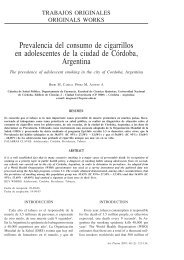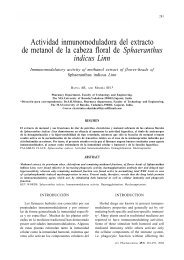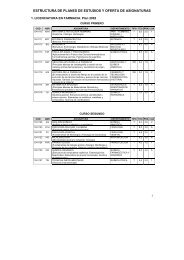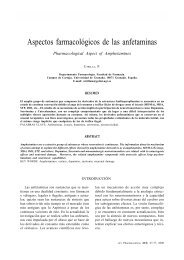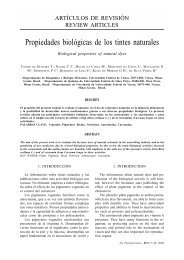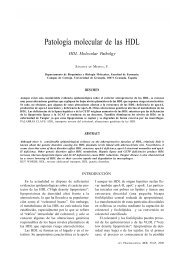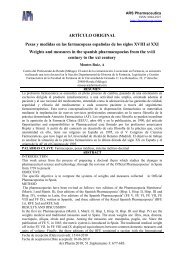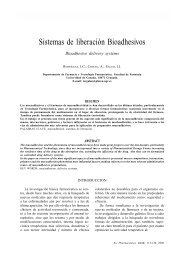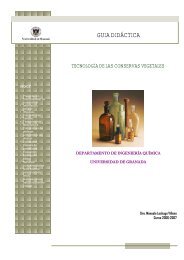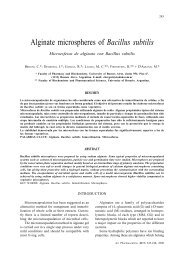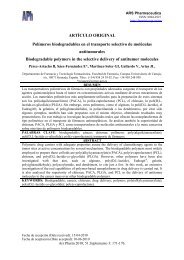Identificación in silico, caracterización molecular y análisis de ...
Identificación in silico, caracterización molecular y análisis de ...
Identificación in silico, caracterización molecular y análisis de ...
You also want an ePaper? Increase the reach of your titles
YUMPU automatically turns print PDFs into web optimized ePapers that Google loves.
78<br />
logía con la sonda utilizada en el <strong>análisis</strong><br />
BLAST. La secuencia <strong>de</strong>l TbPFR3-like compuesta<br />
por las secuencias extraídas se representa<br />
con un recuadro blanco. (B) Amplificación<br />
PCR <strong>de</strong>l homólogo PFR3 <strong>de</strong> T. brucei.<br />
Para la amplificación PCR <strong>de</strong> la secuencia <strong>de</strong>l<br />
PFR3 <strong>de</strong>l ADN genómico <strong>de</strong> T. brucei se utilizaron<br />
oligonucleótidos P1Tb5 y P1Tb3. El<br />
recuadro blanco <strong>in</strong>dica la secuencia <strong>de</strong>l TbPFR3like,<br />
mientras que la posición <strong>de</strong> los oligonucleótidos<br />
se representa mediante flechas. Los<br />
sitios <strong>de</strong> restricción <strong>de</strong> EcoRI y PstI en el ADN<br />
con amplificación 1779 se <strong>in</strong>dican como E y<br />
P respectivamente. Los números se refieren a<br />
la longitud <strong>de</strong>l ADN amplificado. Se muestra<br />
como electroforesis <strong>de</strong> gel <strong>de</strong> agarosa al 1%<br />
<strong>de</strong>l ADN amplificado a 1,8 kb (línea P3Tb),<br />
así como las digestiones <strong>de</strong> EcoRI y PstI <strong>de</strong>l<br />
ADN amplificado (líneas E y P, respectivamente).<br />
Ars Pharm 2005; 46 (1): 73-84.<br />
MORELL M, GARCÍA-PÉREZ JL, THOMAS MC, LÓPEZ MC<br />
served <strong>in</strong> Figure 1B, lane P3Tb, a 1.8 kb<br />
amplified fragment was generated, confirm<strong>in</strong>g<br />
the presence of a PFR3 homologue <strong>in</strong> the T.<br />
brucei genome. The amplified DNA fragment<br />
was analyzed by restriction mapp<strong>in</strong>g us<strong>in</strong>g<br />
EcoRI and PstI enzymes which cut one and<br />
two times, respectively, <strong>in</strong> the T. brucei PFR3<br />
i<strong>de</strong>ntified sequence (nucleoti<strong>de</strong> 387 for Eco-<br />
RI and nucleoti<strong>de</strong>s 1004 and 1594 for PstI,<br />
see schematic map <strong>in</strong> figure 1B). The results,<br />
shown <strong>in</strong> figure 1B, lanes E and P, show fragments<br />
with the expected size for EcoRI- and<br />
PstI- digested T. brucei PFR3 gene. P1Tb fragment<br />
was subsequently cloned <strong>in</strong> pGEM-T<br />
(Promega) and sequenced by the di<strong>de</strong>oxi cha<strong>in</strong>term<strong>in</strong>ation<br />
method 16 <strong>in</strong> a 3100 genetic analyzer<br />
(Applied Biosystems). The nucleoti<strong>de</strong> and<br />
<strong>de</strong>duced am<strong>in</strong>o acid sequences are available<br />
<strong>in</strong> the GenBank data base un<strong>de</strong>r accession<br />
number AY352895). The TbPFR3-like <strong>de</strong>duced<br />
am<strong>in</strong>o acid sequence is a prote<strong>in</strong> of 592<br />
residues with a <strong>molecular</strong> mass of 68.5 kDa



